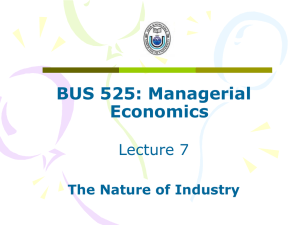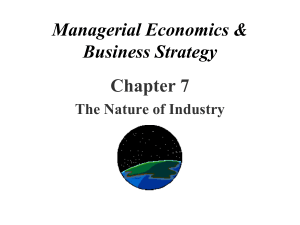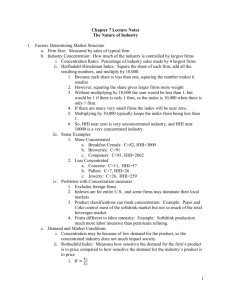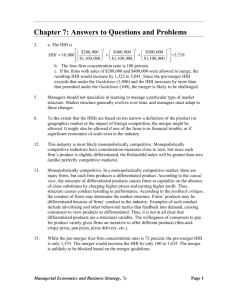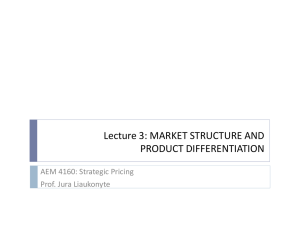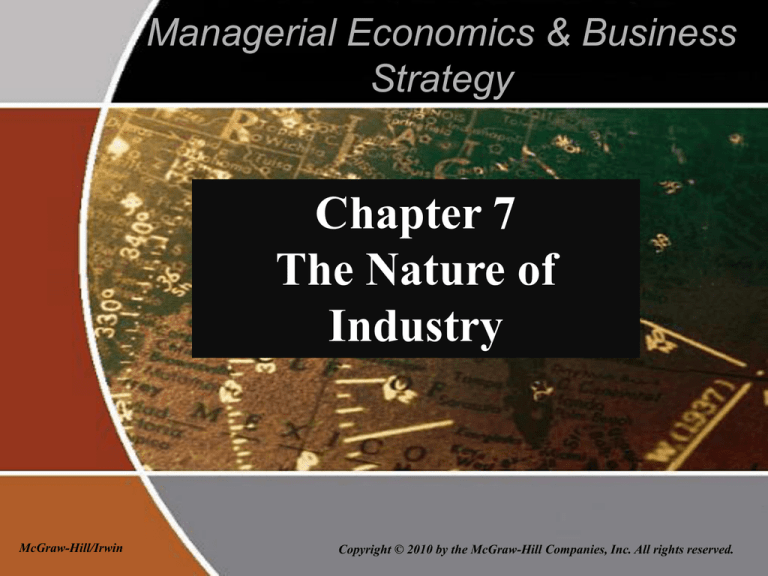
Managerial Economics & Business
Strategy
Chapter 7
The Nature of
Industry
McGraw-Hill/Irwin
Copyright © 2010 by the McGraw-Hill Companies, Inc. All rights reserved.
Industry Structure and Performance
Industries differ substantially in nature.
An effective manager is able to adapt to
the nature of the industry in which s/he
operates.
As the nature of industry changes so will
the manager’s optimal decisions.
7-2
Overview
I. Market Structure
– Measures of Industry Concentration
II. Conduct
– Pricing Behavior
– Integration and Merger Activity
III. Performance
– Structure-Conduct-Performance Paradigm
7-3
Industry Analysis
Market Structure –factors that affect managerial
decisions:
– Number and size of firms –as well as change in
a firm’s relative position can change over time.
Industry’s viability can change (auto, steel,
electronics).
– Industry concentration – are there many small
firms or a few large firms?
– Four-firm Concentration ratio – how much of
total output is produced by the four largest firms.
7-4
Industry Concentration
Four-Firm Concentration Ratio
– The sum of the market shares of the top four firms
in the defined industry. Letting Si denote sales for
firm i and ST denote total industry sales
C4 w1 w2 w3 w4 , where w1
Si
ST
– When an industry is composed of a large number of
small firms the FFCR will be close to zero. With four
or fewer firms in the industry the FFCR will be 1.
– With the FFCR close to zero the industry is not
concentrated.
7-5
Industry Concentration
Herfindahl-Hirschman Index (HHI)
– The sum of the squared market shares of firms in a
given industry, multiplied by 10,000:
– HHI = 10,000 S wi2, where wi = Si/ST.
– The squaring aspect of the HHI weights firms with high
market shares more heavily.
HHI = 10,000 monopoly
HHI = 0 PC
7-6
Example
There are five banks competing in a local
market. Each of the five banks have a 20
percent market share.
What is the four-firm concentration ratio?
C4 0.2 0.2 0.2 0.2 0.8
What is the HHI?
HHI 10,000 .2 .2 .2 .2 .2 2,000
2
2
2
2
2
7-7
Concentration in U.S. Industries
Significant concentration in computers, breweries,
automobiles, distilleries, and snack foods.
Less concentrated are concrete, jewelry, electronic
components, ladies apparel.
High FFCR generally have high HHI.
But there can be differences based on the HHI
including all firms in an industry, and its use of
squared market shares.
7-8
Limitations of Concentration Measures
Exclude foreign imports – tends to overstate true level
of industry concentration when many foreign firms serve
a market.
Based on data from the entire U.S. – in many industries
the relevant markets are local. Using national data tends
to understate the level of concentration.
Definition of the industry – how broad an industry is
defined.
Broadly defined industries would tend to have lower
concentration ratios – Beverages versus colas.
7-9
Industry Analysis
– Technological and cost conditions – differences
according to labor and capital intensity give rise to
different production techniques across industries.
Different techniques result in different costs.
– Demand conditions – low demand implies few firms
generally.
– Information available affects market conditions (airline
tickets - internet; used cars – Ebay?).
– Price elasticity of demand varies between industries
and many times between firms in an industry.
– The Rothschild Index
7-10
Measuring Demand and Market Conditions
The Rothschild Index (R) measures the elasticity of
industry demand for a product relative to that of an
individual firm:
R = ET / EF .
– ET = elasticity of demand for the total market.
– EF = elasticity of demand for the product of an individual firm.
– The Rothschild Index is a value between 0 and 1.
When an industry is composed of many firms, each
producing similar products, the Rothschild index will
be close to zero.
RI provides a measure of how sensitive an individual
firm’s demand is relative to the entire market.
7-11
Own-Price Elasticities of Demand and
Rothschild Indices
Industry
Food
Tobacco
Textiles
Apparel
Paper
Chemicals
Rubber
Elasticity
of Market
Demand
-1.0
-1.3
-1.5
-1.1
-1.5
-1.5
-1.8
Elasticity
of Firm’s
Demand
-3.8
-1.3
-4.7
-4.1
-1.7
-1.5
-2.3
Rothschild
Index
0.26
1.00
0.32
0.27
0.88
1.00
0.78
7-12
Industry Analysis
Ease of entry and exit – optimal decisions of firms in an
industry will depend, in part, on the ease of entry.
Barriers to entry – capital requirements; patents;
economies of scale
Conduct – behavior of firms tends to differ among
industries
– Pricing - firms in some industries can charge higher mark-ups
than in other industries.
– The Lerner Index – a measure of the difference
between price and marginal cost as a fraction of the
price of the product.
7-13
Conduct: Pricing Behavior
The Lerner Index
L = (P - MC) / P
– A measure of the difference
between price and marginal cost
as a fraction of the product’s
price.
– The index ranges from 0 to 1.
• When P = MC, the Lerner
Index is zero; the firm has
no market power.
• A Lerner Index closer to 1
indicates relatively weak
price competition; the firm
has market power.
7-14
Markup Factor
From the Lerner Index, the firm can determine the
factor by which it should price over MC. Rearranging
the Lerner Index
1
P
MC
1 L
The markup factor is 1/(1-L).
– When the Lerner Index is zero (L = 0), the markup factor is 1 and P =
MC.
– When the Lerner Index is 0.20 (L = 0.20), the markup factor is 1.25
and the firm charges a price that is 1.25 times marginal cost.
– The markup charged will vary depending on the nature of the
market in which the good is sold.
7-15
Lerner Indices & Markup Factors
Industry
Food
Tobacco
Textiles
Apparel
Paper
Chemicals
Petroleum
Lerner Index
0.26
0.76
0.21
0.24
0.58
0.67
0.59
Markup Factor
1.35
4.17
1.27
1.32
2.38
3.03
2.44
7-16
Integration and Merger Activity
Integration – uniting productive resources. Can occur
through merger or during the formation of a firm.
Mergers – attempt to reduce transactions costs, realize
economies of scale and scope, increase market
power, or gain easier access to capital markets.
Friendly versus hostile mergers
– Feared by managers in firms not maximizing profits or in some
way mis-managed.
Vertical Integration – various stages of production are
carried out within a single firm. Reduces transaction
costs associated with acquiring inputs.
7-17
Integration and Merger Activity
– Horizontal integration – merging production of a
similar product into a single firm. Done to realize
economies of scale or scope; enhance market power.
– Horizontal merger reduces competition and
increases market power.
– Social benefits of reduced costs must be weighed
against the social costs of more concentration.
7-18
DOJ/FTC Horizontal Merger Guidelines
Based on HHI = 10,000 S wi2, where
wi = Si /ST.
Merger may be challenged if
– HHI exceeds 1800, or would be after merger, and
– Merger increases the HHI by more than 100.
But...
– Recognizes efficiencies: “The primary benefit of mergers
to the economy is their efficiency potential...which can
result in lower prices to consumers...In the majority of
cases the Guidelines will allow firms to achieve
efficiencies through mergers without interference...”
7-19
DOJ/FTC Horizontal Merger Guidelines
DOJ and FTC permit mergers in high HHI industries
if:
there is significant foreign competition,
an emerging technology,
increased efficiencies,
one firm is having financial problems.
Conglomerate mergers - The integration of different product
lines into a single firm.
Economic rationale is not clear – loss of specialization w/o offsetting
synergies.
Possibly merging products with counter-cyclical revenue flows.
Dearth of management talent.
7-20
R&D and Advertising
Advertising – intensity varies over different industries
R&D – used to gain a technological advantage over
competitors by developing patentable products and
processes.
Optimal Advertising and R&D spending depends on
the characteristics of the industry in which the firm
operates.
7-21
Performance
Performance refers to the profits and social welfare
that result in a given industry.
Social Welfare = CS + PS = TS
– Dansby-Willig Performance Index - measure by
how much social welfare would improve if firms in
an industry expanded output in a socially efficient
manner.
– If the DW Index is zero there are no gains to TS if
firms increase output. TS is maximized given
industry demand and cost conditions.
– If DWI>0 the TS would increase if output
increased.
7-22
Dansby-Willig
Performance Index
Industry
Food
Textiles
Apparel
Paper
Chemicals
Petroleum
Rubber
Dansby-Willig Index
0.51
0.38
0.47
0.63
0.67
0.63
0.49
7-23
Approaches to Studying Industry
The Structure-Conduct-Performance (SCP)
Paradigm: Causal View
Market
Structure
Conduct
Performance
The Feedback Critique
– No one-way causal link.
– Conduct can affect market structure.
– Market performance can affect conduct
as well as market structure.
7-24
Relating the Five Forces to the SCP
Paradigm and the Feedback Critique
Entry
Entry Costs
Speed of Adjustment
Sunk Costs
Economies of Scale
Network Effects
Reputation
Switching Costs
Government Restraints
Power of
Input Suppliers
Power of
Buyers
Supplier Concentration
Price/Productivity of
Alternative Inputs
Relationship-Specific
Investments
Supplier Switching Costs
Government Restraints
Level, Growth,
and Sustainability
Of Industry Profits
Industry Rivalry
Concentration
Price, Quantity, Quality,
or Service Competition
Degree of Differentiation
Switching Costs
Timing of Decisions
Information
Government Restraints
Buyer Concentration
Price/Value of Substitute
Products or Services
Relationship-Specific
Investments
Customer Switching Costs
Government Restraints
Substitutes & Complements
Price/Value of Surrogate Products Network Effects
or Services
Government
Price/Value of Complementary
Restraints
Products or Services
7-25
Preview of Coming Attractions
Discussion of optimal managerial
decisions under various market structures,
including:
– Perfect competition
– Monopoly
– Monopolistic competition
– Oligopoly
7-26
Conclusion
Modern approach to studying industries involves
examining the interrelationship between structure,
conduct, and performance.
Industries dramatically vary with respect to
concentration levels.
– The four-firm concentration ratio and
Herfindahl-Hirschman index measure industry
concentration.
The Lerner index measures the degree to which
firms can markup price above marginal cost; it is a
measure of a firm’s market power.
Industry performance is measured by industry
profitability and social welfare.
7-27


